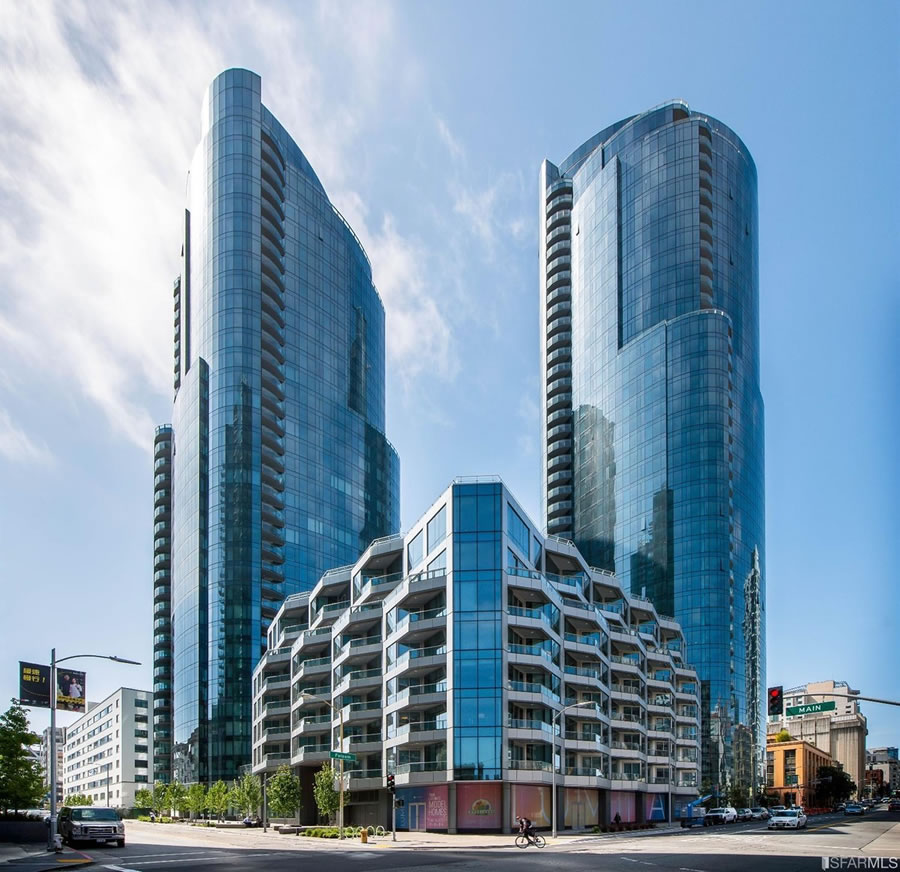Speaking of seller capitulation, the resale of the luxury two-bedroom unit #34C in the Lumina tower at 338 Main Street, which is “considered San Francisco’s best condominium project,” has finally closed escrow.
Purchased for $3.295 million or roughly $2,210 per square foot in June of 2016, which was in-line with other Lumina sales at the time, which collectively established the majority of comps for other units in the neighborhood, the 1,491-square-foot unit was then immediately rented out for around $8,000 per month.
Returned to the market priced at $3.500 million in July of 2020, relisted for $3.500 million in May of 2021, reduced to $3.350 million in September of 2021, relisted for $2.850 million in July of 2022, and then reduced to $2.600 million, the resale of 338 Main Street #34C has now quietly closed escrow with a contract price of $2.325 million, representing a net 29.4 percent drop in value for the two-bedroom luxury unit on an apples-to-apples basis versus an expected gain.
And yes, the widely misreported index for San Francisco condo values is “still up 19 percent!” over the same period of time.







Trying to hold out until a market recovery seems to be a reasonable tactic, but it evidently didn’t work out for this real estate genius. By my count, there are eight (8) other owners trying to rent out their units at present:
• Unit 5A: $5,800 per month for 1,379 ft.²
• Unit 8E: $6,200 per month for ≈ 1,400 ft.²
• Unit 8H: $4,190 per month for 854 ft.²
• Unit 15G: $6,490 per month for 1,401 ft.²
• Unit 20E: $6,850 per month for 1,382 ft.²
• Unit 20D: $4,450 per month for 873 ft.²
• Unit 23H: $4,490 per month for 854 ft.²
• Unit 26B: $20,000 per month for 2,690 ft.² — 4 bedroom, 3 bathroom Lumina Signature Corner residence
If your info is accurate, 8 or 9 vacant units in 655 unit building would be considered low vacancy rate. But that’s not to say they make desirable investments. Leasing could be interim strategy to ride out market dip. Cut rent and shove in tenant on 12 month lease. Then bump the rent at lease expiration after 12 months, when the tenant has settled in with furniture and doesn’t want the inconvenience of moving. Condos aren’t rent controlled in SF, right?
Red herring. First, Brahma says, “by my count,” acknowledging that there may be more that he isn’t aware of. Second, the set of “8 or 9” vacant units for rent is a subset of all vacancies in the building, and neither set intersects with the set of units deployed as short-term or corporate rentals..The set of all units currently neither long-term leased nor owner-occupied (including who knows how many units held vacant due to foreign capital flight, money laundering, or speculation) surely dwarfs 8 or 9 units, but the sorry state of US real estate and rental data does enable your cohort to say, “prove it,” so please go right ahead.
You seem to get off on being contentious. If that comment was directed at me, I don’t know how Brahma got his data so how could I prove anything? Who is the “cohort” you refer to? I am not owner of unit in the building, and I don’t have dog in that fight. Anybody have vacancy rate info on lumina to calm down two beers?
My apologoies in advance for the hit to the feels, but focusing on listed marketed vacancy rates is diversionary. It doesn’t account for shadow inventory in the form of unlisted or simply unmarketed vacancies, short-term and corporate rentals, unmarketed foreign capital flight, unmarketed real estate investment, pieds a terres, or other non-full time residential uses.
As a casual stroll with eyes upward would demonstrate, there is an epic glut of non-family shadow inventory up and down Market, around the “Hub,” and throughtout SOMA. The number of currently-listed units, which in the absence of an accurate inventory report is the researchable numerator used to determine “vacancy rate”, massively downplays the extent of the carnage.
Paying a 34.3 GRM never will make you any money.
Has buying a moderately recently-constructed (Lumina Towers units were built in 2016) luxury condo unit in S.F. to put on the lease market ever really made business sense for small-time landlords? It doesn’t seem like the numbers have worked out at any point over the last decade and a half once you account for all the expenses including but not limited to $1,200+ monthly HOA dues.
I’m pretty sure I picked up this idea from Dave (Seattle dude) in these comment threads somewhere: local mom and pop landlord types who were doing this after the dot com collapse era were essentially placing a kind of real-estate backed derivative bet. They were planning to obtain a substantial capital gain when they sold the unit; the rental income stream was just a way to defray their carrying costs. And for most of that period, when prices were rising monotonically, it seems like it worked out.
Foreign buyers just wanted to park their excess (possibly corruption-derived) income outside their home country, so they weren’t paying too close attention to the gross rent multiplier.
Just wondering whewther these vacancies are covered by the new Vacancy Taxes
For the high-valued units in this particular building, it’s probable that their owners have their taxes handled by a professional, and so they’ll file and pay appropriately. But in general, I have dealt with enough mom and pop landlord types over the years that I fully expect there to be little actual payment of the taxes envisioned by Proposition M in November 2022.
I’m not a land use attorney, but SEC. 2952 says ““Vacant” means unoccupied, uninhabited, or unused, for more than 182 days, whether consecutive or nonconsecutive, in a tax year.” Just before that, it lists eight different “Vacancy Exclusion Periods”.
I think that in general city-wide, the AirBnB “superhosts” and faux libertarian landlords will just never admit that their units were vacant for that long and simply won’t file or pay, especially if they are in the habit of preparing their own taxes. They’ll just try and work around it by saying they were exempt due to one or more of the exclusion periods, or that the unit was only vacant for 181 days or less.
I admit I don’t understand how the city is supposed to prove that a unit that was vacant for an extended period was in fact vacant if the owner decides to lie about it in support of their own pecuniary interest.
IMO vacancy tax is gimmick. Its not going to move the needle much for affordability. If you’re not willing to overpay for the privilege of SF cost of living, there is decent quality of life in places such as santa rosa for example, that would still allow access to SF. Maybe that’s triggering for some because it violates their personal sense of fairness.
If the S.F. landholding class really is engaged in some kind of long term John Galt-ian strke against residents and actively supporting displacement by taking thousands of properties off the market indefinitely, artificially lowering supply, then passing Proposition M will still have been worth it even if it doesn’t raise much tax revenue. That will be because the data collected and the subsequent possible prosecutions of owners for non-payment of the vacancy tax (using the ad hoc techniques I outlined above) will bring that fact to widespread public notice, and then the YIMBY crowd will have to STFU with their “build our way out of the housing crisis” nonsense.
So while I agree that the vacancy tax might not be worth it in terms of revenue, it might very well be useful for moving the political conversation forward in a meaningful way.
At the level of $1,559 per ft.² implied by this sale, the current market value of Unit 22G in this same complex should be just above $1,946,000. But it’s been on the market since September and had it’s price lowered to $1,790,000 a couple of months ago. The discount for being a dozen floors lower can’t be that great, can it?